Risto Wichman
On the Average Secrecy Performance of Satellite Networks in Short Packet Communication Systems
May 13, 2025Abstract:This paper investigates the secrecy performance of satellite networks in short packet communication systems under shadowed Rician fading (SRF). We derive a lower bound on the average achievable secrecy rate in the finite blocklength regime (FBL) and provide analytical insights into the impact of key secrecy-related performance indicators (KPIs). Monte Carlo simulations validate the theoretical framework, and demonstrate that increasing the blocklength and improving the legitimate receiver's signal-to-noise ratio (SNR) enhance secrecy, while a stronger eavesdropper degrades it. Additionally, we show that directional antenna patterns can effectively reduce information leakage and provide secure satellite communications in the short packet regime. These findings offer valuable guidance for designing secure and efficient satellite-based communication systems, particularly in IoT and space-based networks.
Real-time Tracking System with partially coupled sources
Mar 27, 2025Abstract:We consider a pull-based real-time tracking system consisting of multiple partially coupled sources and a sink. The sink monitors the sources in real-time and can request one source for an update at each time instant. The sources send updates over an unreliable wireless channel. The sources are partially coupled, and updates about one source can provide partial knowledge about other sources. We study the problem of minimizing the sum of an average distortion function and a transmission cost. Since the controller is at the sink side, the controller (sink) has only partial knowledge about the source states, and thus, we model the problem as a partially observable Markov decision process (POMDP) and then cast it as a belief-MDP problem. Using the relative value iteration algorithm, we solve the problem and propose a control policy. Simulation results show the proposed policy's effectiveness and superiority compared to a baseline policy.
3D Reconfigurable Intelligent Surfaces for Satellite-Terrestrial Networks
May 21, 2024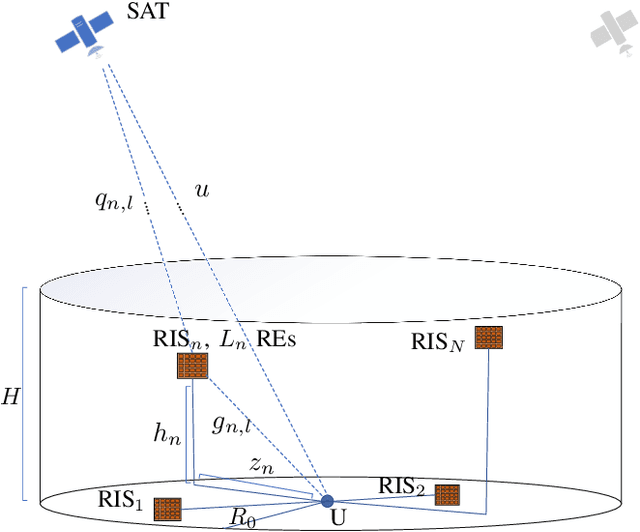
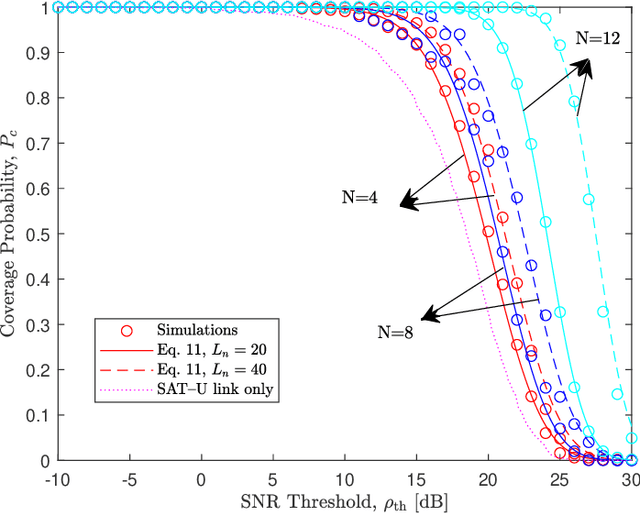
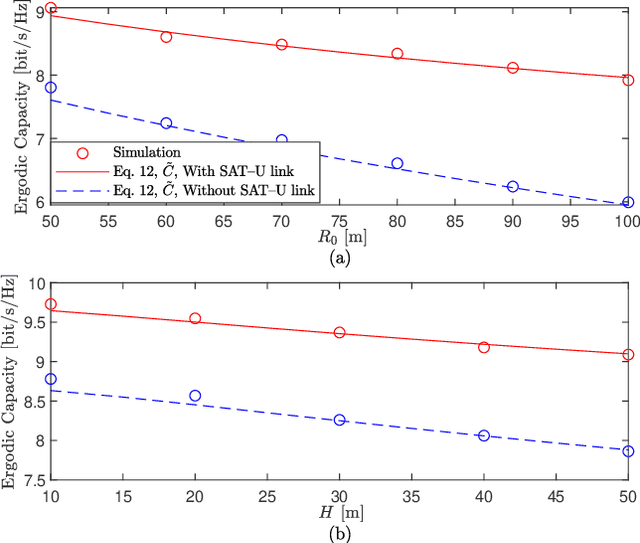
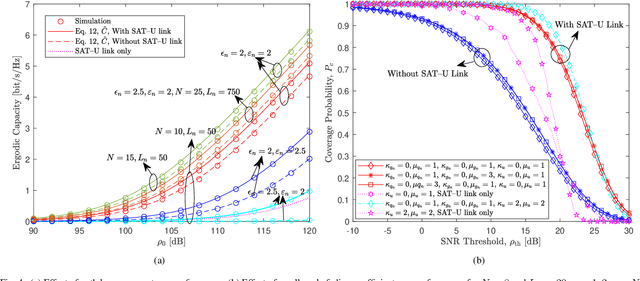
Abstract:This paper proposes a three-dimensional (3D) satellite-terrestrial communication network assisted with reconfigurable intelligent surfaces (RISs). Using stochastic geometry models, we present an original framework to derive tractable yet accurate closed-form expressions for coverage probability and ergodic capacity in the presence of fading. A homogeneous Poisson point process models the satellites on a sphere, while RISs are randomly deployed in a 3D cylindrical region. We consider nonidentical channels that correspond to different RISs and follow the {\kappa}-{\mu} fading distribution. We verify the high accuracy of the adopted approach through Monte Carlo simulations and demonstrate the significant improvement in system performance due to using RISs. Furthermore, we comprehensively study the effect of the different system parameters on its performance using the derived analytical expressions, which enable system engineers to predict and optimize the expected downlink coverage and capacity performance analytically.
On array geometry and self-interference in full-duplex massive MIMO communications
Jan 12, 2024
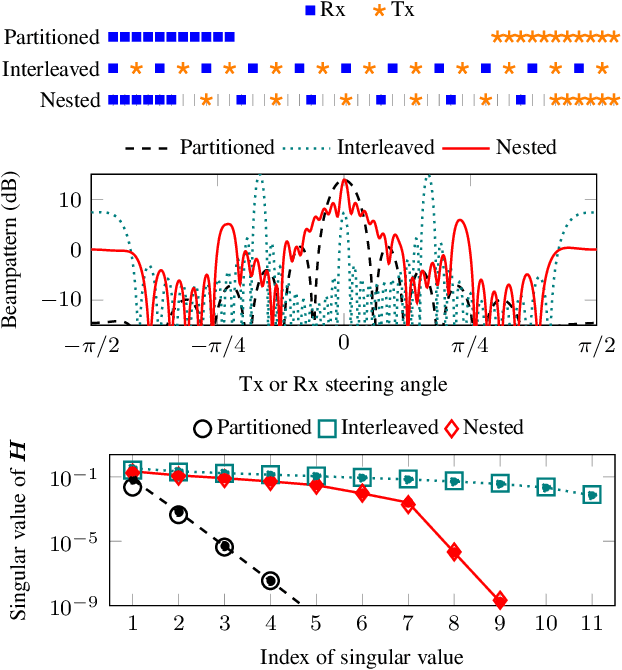
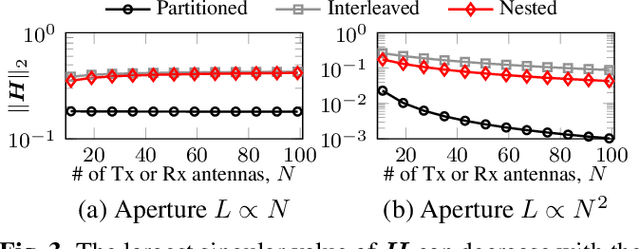
Abstract:This paper studies the role of the joint transmit-receive antenna array geometry in shaping the self-interference (SI) channel in full-duplex communications. We consider a simple spherical wave SI model and two prototypical linear array geometries with uniformly spaced transmit and receive antennas. We show that the resulting SI channel matrix has a regular (Toeplitz) structure in both of these cases. However, the number of significant singular values of these matrices - an indication of the severity of SI - can be markedly different. We demonstrate that both reduced SI and high angular resolution can be obtained by employing suitable sparse array configurations that fully leverage the available joint transmit-receive array aperture without suffering from angular ambiguities. Numerical electromagnetic simulations also suggest that the worst-case SI of such sparse arrays need not increase - but can actually decrease - with the number of antennas. Our findings provide preliminary insight into the extent to which the array geometry alone can mitigate SI in full-duplex massive MIMO communications systems employing a large number of antennas.
Index Modulation-based Information Harvesting for Far-Field RF Power Transfer
Sep 24, 2023Abstract:While wireless information transmission (WIT) is evolving into its sixth generation (6G), maintaining terminal operations that rely on limited battery capacities has become one of the most paramount challenges for Internet-of-Things (IoT) platforms. In this respect, there exists a growing interest in energy harvesting technology from ambient resources, and wireless power transfer (WPT) can be the key solution towards enabling battery-less infrastructures referred to as zero-power communication technology. Indeed, eclectic integration approaches between WPT and WIT mechanisms are becoming a vital necessity to limit the need for replacing batteries. Beyond the conventional separation between data and power components of the emitted waveforms, as in simultaneous wireless information and power transfer (SWIPT) mechanisms, a novel protocol referred to as information harvesting (IH) has recently emerged. IH leverages existing WPT mechanisms for data communication by incorporating index modulation (IM) techniques on top of the existing far-field power transfer mechanism. In this paper, a unified framework for the IM-based IH mechanisms has been presented where the feasibility of various IM techniques are evaluated based on different performance metrics. The presented results demonstrate the substantial potential to enable data communication within existing far-field WPT systems, particularly in the context of next-generation IoT wireless networks.
Information Harvesting for Far-Field Wireless Power Transfer
May 26, 2021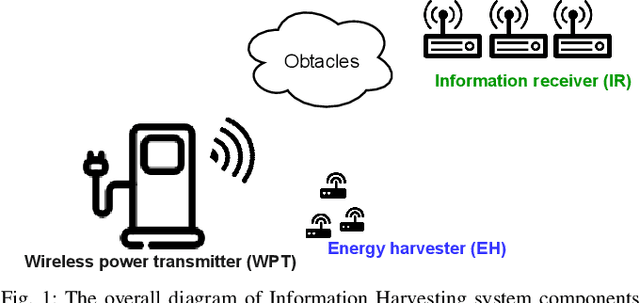
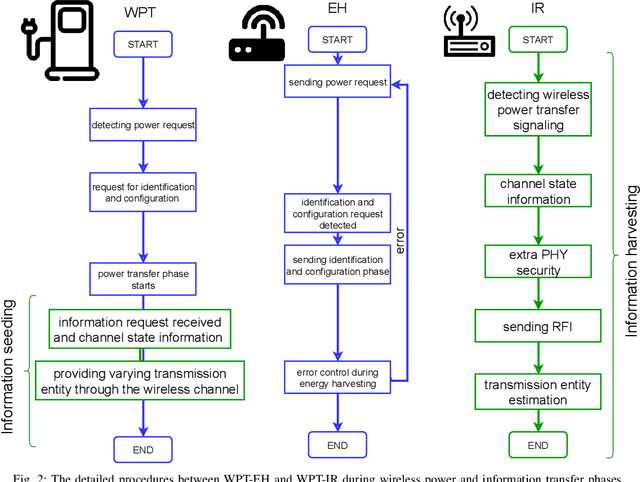
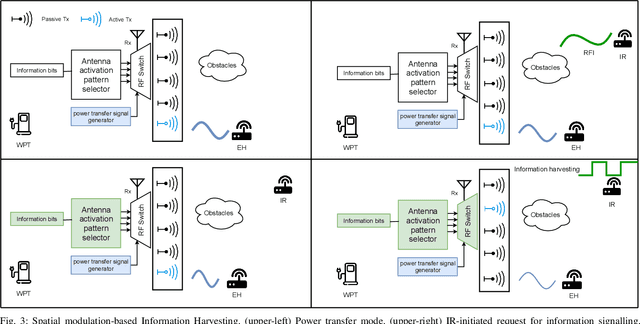
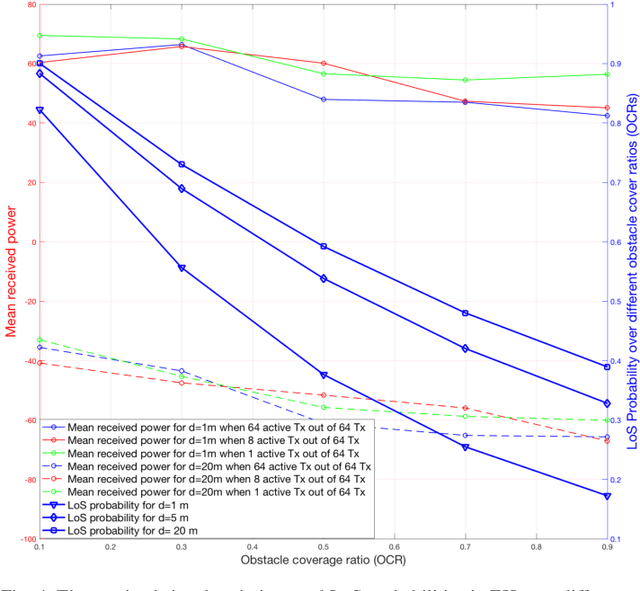
Abstract:Considering ubiquitous connectivity and advanced information processing capability, huge amount of low-power IoT devices are deployed nowadays and the maintenance of those devices which includes firmware/software updates and recharging the units has become a bottleneck for IoT systems. For addressing limited battery constraints, wireless power transfer is a promising approach such that it does not require any physical link between energy harvester and power transfer. Furthermore, combining wireless power transfer with information transmission has become more appealing. In the systems that apply radio signals the wireless power transfer has become a popular trend to harvest RF-radiated energy from received information signal in IoT devices. For those systems, design frameworks mainly deal with the trade-off between information capacity and energy harvesting efficiency. Therein various signaling design frameworks have been proposed for different system preferences between power and information. In addition to this, protecting the information part from potential eavesdropping activity in a service area introduces security considerations for those systems. In this paper, we propose a novel concept, Information Harvesting, for wireless power transfer systems. It introduces a novel protocol design from opposite perspective compared to the existing studies. Particularly, Information Harvesting aims to transmit information through existing wireless power transfer mechanism without interfering/interrupting power transfer.
Visible light communication-based monitoring for indoor environments using unsupervised learning
Jan 20, 2021Abstract:Visible Light Communication~(VLC) systems provide not only illumination and data communication, but also indoor monitoring services if the effect that different events create on the received optical signal is properly tracked. For this purpose, the Channel State Information that a VLC receiver computes to equalize the subcarriers of the OFDM signal can be also reused to train an Unsupervised Learning classifier. This way, different clusters can be created on the collected CSI data, which could be then mapped into relevant events to-be-monitored in the indoor environments, such as the presence of a new object in a given position or the change of the position of a given object. When compared to supervised learning algorithms, the proposed approach does not need to add tags in the training data, simplifying notably the implementation of the machine learning classifier. The practical validation the monitoring approach was done with the aid of a software-defined VLC link based on OFDM, in which a copy of the intensity modulated signal coming from a Phosphor-converted LED was captured by a pair of Photodetectors~(PDs). The performance evaluation of the experimental VLC-based monitoring demo achieved a positioning accuracy in the few-centimeter-range, without the necessity of deploying a large number of sensors and/or adding a VLC-enabled sensor on the object to-be-tracked.
 Add to Chrome
Add to Chrome Add to Firefox
Add to Firefox Add to Edge
Add to Edge